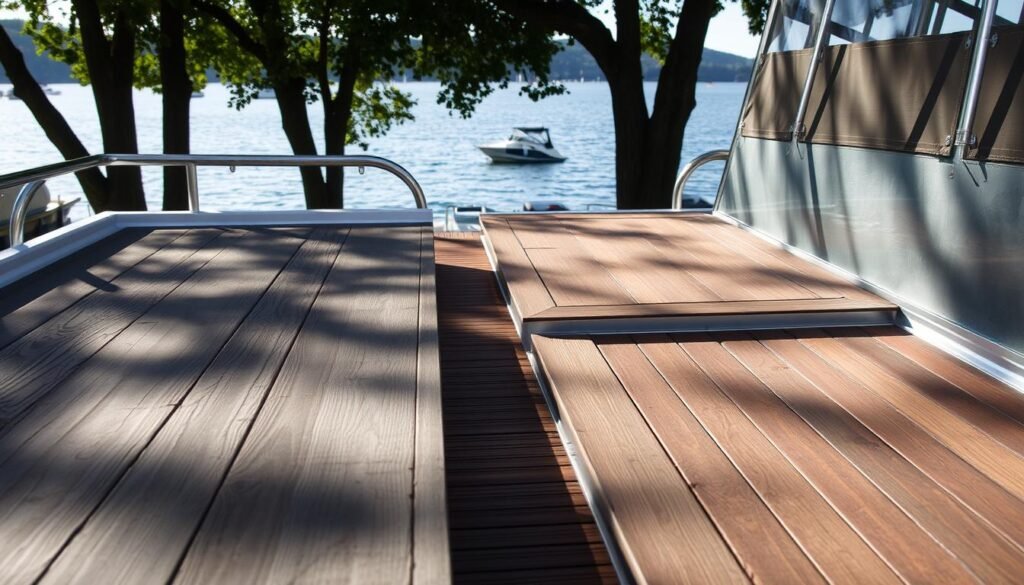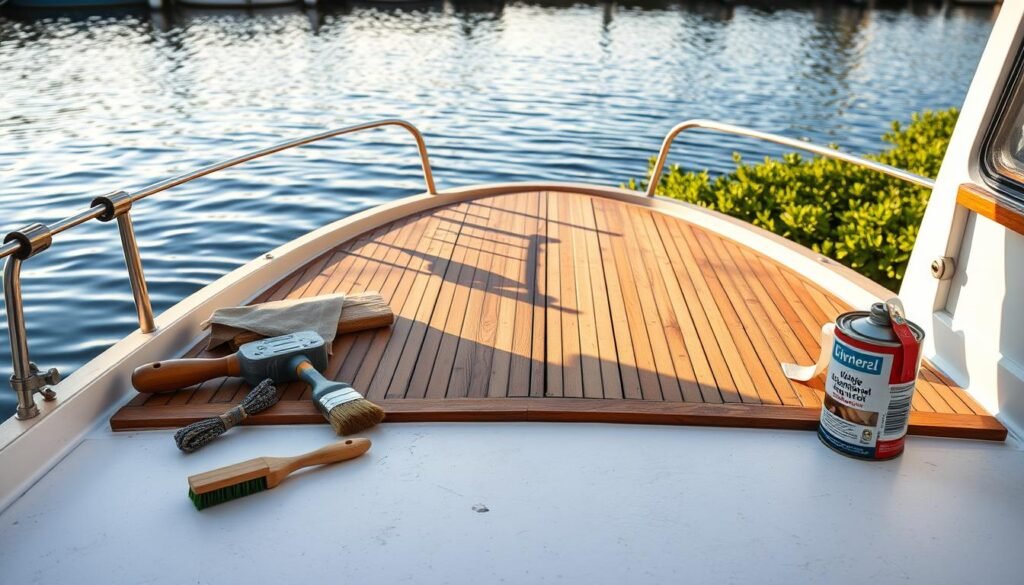Ever thought about what makes a pro boat deck different from a DIY one? Learning about boat deck building can make your boat stand out.
Building a DIY boat deck needs precision, knowledge, and the right stuff. It’s a mix of technical skills and creative thinking. Whether you’re into boating a lot or just on weekends, knowing how to build a boat deck can make your time on the water better.
Building a boat deck means picking the right materials, knowing what the structure needs, and using methods that last. From choosing wood to figuring out deck thickness and how to fasten it, every little thing counts. It’s all about making a deck that’s strong and works well.
Key Takeaways
- Master the fundamentals of DIY boat deck construction
- Select materials that provide durability and performance
- Understand critical measurements for deck thickness
- Learn proper fastening techniques for long-lasting results
- Recognize the importance of precision in maritime deck building

Understanding the Basics of Boat Deck Construction
Building a boat deck is key for watercraft fans and DIY experts. It needs a solid grasp of deck basics and careful planning.
Building a strong boat deck is all about safety, durability, and performance. It requires precision and knowledge of different techniques and materials.
Importance of a Good Deck
A good boat deck does many important things:
- It gives the boat its structure
- It keeps passengers safe
- It stops water damage
- It makes the boat perform better
Key Features of a Boat Deck
Professional boat deck basics include a few key features:
- Waterproofing to keep moisture out
- Non-slip surfaces for safety
- Good drainage systems
- Strong structural design
Common Materials Used
Choosing the right materials is key in deck building. You have both traditional and modern options:
- Teak (classic marine wood)
- Mahogany (durable and elegant)
- Cedar (lightweight and resistant)
- Composite materials (easy to maintain)
“A superior boat deck begins with understanding materials and techniques.”
Experts know that the right materials make a big difference. They affect how well the deck lasts, how it performs, and how much upkeep it needs. Each material has its own benefits for building a boat deck.
Planning Your Boat Deck Project
Creating successful boat deck plans needs careful preparation and smart thinking. Nautical deck design is not just about looks. It’s about making your boat safe, functional, and the best it can be. Knowing the key planning elements will help you make affordable and effective boat deck ideas.
Assessing Your Space
Look at your boat’s current layout and deck space. Think about these points:
- Total deck square footage
- Current structural limitations
- Intended use of the deck (fishing, leisure, storage)
- Weight capacity requirements
Setting a Budget
Creating affordable boat deck ideas means setting a realistic budget. Your budget should cover:
- Material costs
- Tools and equipment
- Potential professional consultation
- Contingency funds for unexpected expenses
| Budget Category | Estimated Cost Range |
|---|---|
| Materials | $200 – $800 |
| Tools | $100 – $300 |
| Professional Advice | $50 – $250 |
| Contingency | 10-15% of total budget |
Permits and Regulations
Understanding local regulations is key for nautical deck design. Look into your area’s specific rules:
- Contact local marine authorities
- Verify required permits
- Review zoning restrictions
- Check environmental guidelines
Pro tip: Always get the necessary permissions before starting your boat deck project to avoid legal issues.
With good planning, your boat deck can become a standout feature. It will meet your needs and look great.
Choosing the Right Materials
Choosing the right boat deck materials is key for a durable and lasting marine surface. Your choice affects the deck’s performance, upkeep, and the boat’s look.

Exploring wooden deck options for boats involves several important factors. Each material has its own benefits and challenges for marine use.
Types of Wood for Boat Decks
Premium hardwoods are top choices for marine-grade deck materials:
- Teak: Naturally water-resistant and very durable
- Mahogany: Looks great and is strong
- Cedar: Light and resists moisture decay
Alternatives to Wood
Today, there are many boat deck materials beyond wood:
- Marine-grade plywood: Affordable and versatile
- Fiberglass: Easy to maintain and light
- Composite materials: Durable with little upkeep
Accessories and Hardware
Choosing the right deck materials means picking the right hardware too:
| Component | Recommended Material | Key Benefit |
|---|---|---|
| Fasteners | Stainless Steel | Corrosion Resistance |
| Sealants | Marine-Grade Epoxy | Water Protection |
| Finishes | UV-Resistant Coating | Surface Longevity |
“The right materials make the difference between a good boat deck and a great one.” – Marine Engineering Expert
Pro tip: Always choose high-quality, marine-specific materials. This ensures your boat deck lasts through harsh water conditions and provides reliable service for years.
Designing Your Boat Deck
Creating the perfect boat deck needs careful planning and creativity. A well-designed deck turns your boat into a floating home that’s both functional and stylish.
When designing your boat deck, you must think about several key factors. These factors affect the layout and look of your deck.
Deck Layout Considerations
Good boat deck design starts with knowing what you need. Different boats need different deck setups:
- Sports boats need fast, dynamic layouts
- Leisure boats require large, comfy deck areas
- Fishing boats need special zones for gear
Creating Functional Boat Deck Zones
Great deck designs have zones for different uses. Think about dividing your deck into areas for:
- Sunbathing
- Entertainment
- Storage
- Mounting equipment
Aesthetics and Style Selection
The look of your deck is just as important as its use. Modern designs offer many styles:
| Design Category | Cost | Visual Impact |
|---|---|---|
| No-Margin Design | Most Cost-Effective | Minimalist |
| Part Margin Design | Moderate | Balanced |
| Fully Margined Deck | Most Expensive | Luxurious |
“A well-designed boat deck is not just about appearance, but about creating a space that enhances your maritime experience.” – Nautical Design Expert
Choosing colors like Teak/Black can boost your boat’s value and look. Synthetic materials like Nuteak offer durable, modern looks.
Preparing the Site
Preparing a boat deck needs careful planning and the right tools. Knowing the key steps in site preparation is vital for a successful marine carpentry project.
Clearing the Work Area
The first step is to make a clean, organized workspace. Get rid of all debris, plants, and things that could get in the way of building.
- Clear a flat surface at least 2-3 feet larger than your planned deck
- Remove rocks, roots, and uneven ground
- Ensure proper drainage around the construction area
Ground Stability Checks
Stability is key for a strong boat deck. Do a thorough check of the ground to avoid future problems.
| Ground Assessment | Recommended Action |
|---|---|
| Soil Compactness | Use a tamper to create a solid foundation |
| Water Drainage | Check for areas where water might collect |
| Ground Level | Use a professional level to check for evenness |
Essential Marine Carpentry Tools
Having the right tools is essential for a successful boat deck project.
- Circular saw for precise cuts
- Cordless 18V screwdriver
- Measuring tape and level
- Safety equipment (goggles, gloves)
- Post hole digger
“Proper preparation prevents poor performance in boat deck construction.”
For the best results, choose quality tools and spend time on site preparation. Pay attention to detail in the preparation phase for a durable and good-looking boat deck.
Building the Framework
Creating a solid boat deck framework is key for your marine vessel’s strength and life span. The deck joist construction is the core of your boat’s deck. It gives essential support and stability.
When framing your marine deck, keep these important points in mind for a strong and dependable structure:
- Select high-quality lumber resistant to marine environments
- Use marine-grade fasteners to prevent corrosion
- Implement precise measurements for optimal structural integrity
Constructing the Joists
The boat deck framework depends on well-made joists that spread weight evenly. Experts suggest using fir or spruce wood, possibly mixing with oak or ash for more strength. Here are key steps for building deck joists:
- Cut lumber to precise specifications
- Apply waterproof sealant at all joints
- Ensure minimum of five lamination layers for structural rigidity
Securing the Frame
Proper attachment is critical in deck joist construction. Use exterior-grade plywood with few knots and strategic bolt placement to hold the deck frame together.
| Material | Recommended Use | Durability Rating |
|---|---|---|
| Fir Plywood | Primary Framing | High |
| Marine-Grade Fasteners | Connections | Excellent |
| Waterproof Sealant | Joint Protection | Superior |
Ensuring Levelness
To achieve a level boat deck framework, pay close attention to detail. Use precise measuring tools and adjustable shims for a perfectly balanced surface. The aim is to evenly distribute forces across the entire deck structure.
A well-constructed deck framework is the foundation of a safe and reliable marine vessel.
With careful planning and execution, your marine deck framing will last for years on the water.
Download over 500 Boat Plans. Click on the link below.
-->Click Here<--
Installing Decking Boards
Installing decking boards needs precision and planning. It’s key to make a durable and attractive marine deck. Professional boat builders know the right steps make a big difference.
Choosing the right decking boards is vital for marine use. Different installation styles can change a boat’s look and function:
- Traditional Style: Looks like classic teak decks with margin boards
- New York Style: A modern look with no margin boards
- Synthetic Materials: Last longer in harsh weather
Proper Spacing Techniques
Wood deck expansion needs careful spacing. Experts say keep at least 1/8″ gap between boards for movement and air. Boards should be 6″ wide to prevent cupping and bowing.
Fastening Methods
Marine deck fastening needs top-notch materials and methods. Here are some key ones:
| Fastening Method | Best Used For | Recommended Hardware |
|---|---|---|
| Hidden Deck Screws | Looks professional | Protec-Kote Screws |
| Exposed Fasteners | Fast to install | Galvanized Steel Screws |
Handling Expansion and Contraction
Wood deck expansion is key in marine settings. Different materials handle temperature and humidity changes differently:
- Cedar and redwood: Shrink less
- Treated lumber: More movement
- Synthetic materials: Most stable
Pro Tip: Always pre-drill holes and use quality fasteners to prevent splitting and ensure a secure, long-lasting deck installation.
By following these tips, boat owners can build a strong and lovely deck. It will last through marine conditions and offer years of fun.
Adding Safety Features
Boat deck safety is key for any watercraft owner. It’s about making a safe space for everyone on board. This means planning carefully and adding important safety features.
Marine Deck Railings
Deck railings are vital for keeping everyone safe. Here are some key things to remember when setting up marine deck railings:
- Stanchions must withstand 63 pounds of force with minimal deflection
- Clip-in points require a minimum breaking strength of 1,350 pounds
- Maximum space between handholds should not exceed 4.5 feet
- Recommended footstop height varies by sailing category
Non-Slip Deck Treatments
Slippery surfaces on boats are a big risk. Non-slip deck treatments are a must for safety and grip.
| Product | Price | Coverage |
|---|---|---|
| Interlux 2398 Polymeric Noskid Compound | $6.95 per 8 oz | Requires deck enamel |
| Monster Grip Non-Skid Safety Coating | $46.00 per gallon | Comprehensive coverage |
| Treadmaster Original M | $79.99-$94.95 | Multiple color options |
Lighting for Enhanced Safety
Good lighting is a must for safe nighttime sailing. Think about adding:
- Recessed LED lights for a modern look
- Traditional marine lanterns for a classic feel
- Waterproof electrical setups
- Well-placed lights
Safety isn’t expensive, it’s priceless. Invest in quality marine safety features to protect your crew and vessel.
Always follow maritime safety rules. Also, check your boat deck’s safety features often to keep everyone safe.
Maintenance Tips for Your Boat Deck
Keeping your boat deck in top shape is key. Regular care keeps it looking good and working well. This saves you money and makes your deck last longer.

Boat deck maintenance covers a few important steps. Knowing how to care for marine wood can save you a lot of time and money.
Regular Inspection Routine
It’s important to check your deck often. Look for these things:
- Fastener stability and tightness
- Signs of water damage
- Wood surface integrity
- Structural connections
Seasonal Care and Upkeep
Deck repair needs change with the seasons. Different weather calls for different care.
| Season | Maintenance Action |
|---|---|
| Summer | UV protection application |
| Winter | Weatherproofing sealants |
| Spring/Fall | Deep cleaning and inspection |
Repairing Damaged Areas
Fixing deck damage quickly stops it from getting worse. Here are three good marine sealants:
- Silicone: Easy to use, stands up to chemicals
- Polysulfide: Synthetic rubber, perfect for teak decks
- Polyurethane: Strong adhesive for lasting fixes
Proactive maintenance is the key to preserving your boat deck’s performance and appearance.
Always clean the surface before sealing. For tough repairs, get expert advice. Regular upkeep can cut repair costs by up to 30%.
Enjoying Your New Boat Deck
Your boat deck is now more than just a place to stand. It’s a fun spot for relaxation, play, and hanging out with friends. With some planning, it turns into your own special outdoor space.
There are endless ways to make your deck entertaining. You could add special fishing spots, comfy sun loungers, or places to store your water toys. Adding plants, marine furniture, and lights can make it look great and feel welcoming at night.
Having parties on your deck is a breeze. Whether it’s a small get-together or a big event, your deck is ready. Just remember to keep it safe and balanced for everyone’s comfort. Your deck is a lively part of your life, showing off your love for the sea and your creativity.
Ideas for Deck Activities
Think about all the fun things you can do on your deck. You can fish, watch wildlife, do yoga, or even have a picnic. It’s a place where you can enjoy the sea and have fun.
Incorporating Landscaping
Choose plants and decorations that can handle saltwater. Adding greenery and nautical touches can make your deck look amazing. It will blend beautifully with the water around it.
Hosting Gatherings and Events
Plan your deck with parties in mind. Set up areas for sitting, eating, and fun for all kinds of groups. Your deck will be the perfect spot for unforgettable moments by the water.
FAQ
What are the best materials for building a boat deck?
The top choices for boat decks are hardwoods like teak, mahogany, and cedar. Modern options include marine-grade plywood, fiberglass, and composites. Your choice depends on budget, boat type, and how much upkeep you want.
How much does it cost to build a boat deck at home?
Costs vary a lot. For a DIY deck, expect to spend $500 to $5,000. Prices change based on materials, deck size, and features. Doing it yourself can save money, but professional help might be needed for some tasks.
Do I need special permits to build a boat deck?
Yes, you might need permits for significant changes or use in public waters. Check with local authorities and boat clubs to follow safety and building rules.
How do I prevent my boat deck from becoming slippery?
Use non-slip treatments like textured paints or adhesive strips. Choose materials with natural grip or add non-skid coatings. Textured composites or overlays also work well.
How often should I maintain my boat deck?
Clean and inspect your deck twice a year. Wooden decks need more care, while composites require less. Always check fasteners and address wear or damage.
Can I install a boat deck by myself?
Many DIYers build their decks successfully. You’ll need a plan, the right tools, and carpentry skills. If unsure, get professional help or take a workshop.
What tools do I need to build a boat deck?
You’ll need a circular saw, jigsaw, drill, and measuring tools. Don’t forget safety gear, fasteners, and sealants. Marine tools are essential for some tasks. Choose quality, safe tools.
How long does it take to build a boat deck?
Time depends on the deck’s size, complexity, and your skill. Simple decks might take a weekend, while complex ones could take 1-2 weeks. Plan for all steps, from planning to finishing.
What are the most common mistakes in boat deck construction?
Mistakes include poor waterproofing, bad drainage, wrong materials, and wrong fasteners. Don’t ignore expansion and contraction or boat-specific needs. Always research and consider expert advice.
Can I customize my boat deck for specific activities?
Yes! Customize your deck for fishing, sunbathing, or entertainment. Add features like rod holders, seating, storage, and lighting. Make it safe and functional for your favorite activities.



